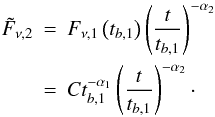| Issue |
A&A
Volume 526, February 2011
|
|
|---|---|---|
| Article Number | A23 | |
| Number of page(s) | 20 | |
| Section | Extragalactic astronomy | |
| DOI | https://doi.org/10.1051/0004-6361/201015581 | |
| Published online | 15 December 2010 | |
Online material
Appendix A: Smoothly broken power law of the order m
The equation for a smoothly broken power-law of the order m,
Fν,m(t), was derived by
recursion in the following way. Let us assume the function
Fν,m(t) consists of
m power-law segments connected by (m − 1) breaks. To
add an additional power-law segment  , we first normalised the new power-law
segment to the previous one,
Fν,m(t), at the break
time tb,m:
, we first normalised the new power-law
segment to the previous one,
Fν,m(t), at the break
time tb,m:  (A.1)Here
αm + 1 is the slope of segment
(m + 1). Second, we followed Beuermann
et al. (1999) and introduced a smoothness
parameter nm so that the smoothly
broken power law of order the (m + 1) takes the form
(A.1)Here
αm + 1 is the slope of segment
(m + 1). Second, we followed Beuermann
et al. (1999) and introduced a smoothness
parameter nm so that the smoothly
broken power law of order the (m + 1) takes the form  (A.2)If the light-curve consists of
m segments, both steps (adding and smoothing) have to be performed
(m − 1)-times.
(A.2)If the light-curve consists of
m segments, both steps (adding and smoothing) have to be performed
(m − 1)-times.
For example, let us derive the equation for a smoothly broken power-law (Beuermann et al. 1999). In this case
m = 2, thus the function consists of two power-law segments connected
by one break at the time tb,1. The initial
function is a simple power law
Fν,1(t) = C t−α1.
First, the second power-law segment,  , has to be connected to the first one at
the time tb,1 (step A.1)
, has to be connected to the first one at
the time tb,1 (step A.1)  Second, the transition has to be smoothed
by weighting both functions at the point of intersection (step A.2)
Second, the transition has to be smoothed
by weighting both functions at the point of intersection (step A.2)  This leads to the equation found by Beuermann et al. (1999) for a smoothly broken
power-law. Repeating both steps leads to a smoothly broken power-law of the order 3
(double smoothly broken power-law; Liang et al.
2008). Thus, looping (m − 1)-times over both steps results in
a smoothly broken power law of the order m.
This leads to the equation found by Beuermann et al. (1999) for a smoothly broken
power-law. Repeating both steps leads to a smoothly broken power-law of the order 3
(double smoothly broken power-law; Liang et al.
2008). Thus, looping (m − 1)-times over both steps results in
a smoothly broken power law of the order m.
Appendix B: Tables
Properties of the afterglow SEDs in the optical and X-ray bands of the 27 bursts that entered our sample.
Light-curve parameters of the late-time optical and X-ray afterglows of the 27 bursts that entered our sample.
Identification of the light-curve segments and the circumburst medium.
 |
Fig. C.1
Optical and X-ray afterglow light curves of the 27 bursts that entered our
sample. Upper panel: the optical data in the
Rc band are shown as dots and the X-ray data at
1.73 keV as bigger dots with an error bar in time. The light-curve fits are
over-plotted. Upper limits are shown as downwards-pointing triangles. The grey box
is the overlapping time interval of the late-time evolution. Vertical dotted and
dashed lines indicate breaks in the optical and X-ray band. Information on the
SEDs are shown in the bottom left (see also Table B.1). The given extinction, |
| Open with DEXTER | |
 |
Fig. C.1
continued. |
| Open with DEXTER | |
 |
Fig. C.1
continued. |
| Open with DEXTER | |
 |
Fig. C.1
continued. |
| Open with DEXTER | |
 |
Fig. C.1
continued. |
| Open with DEXTER | |
 |
Fig. C.1
continued. |
| Open with DEXTER | |
 |
Fig. C.1
continued. |
| Open with DEXTER | |
© ESO, 2010
Current usage metrics show cumulative count of Article Views (full-text article views including HTML views, PDF and ePub downloads, according to the available data) and Abstracts Views on Vision4Press platform.
Data correspond to usage on the plateform after 2015. The current usage metrics is available 48-96 hours after online publication and is updated daily on week days.
Initial download of the metrics may take a while.





